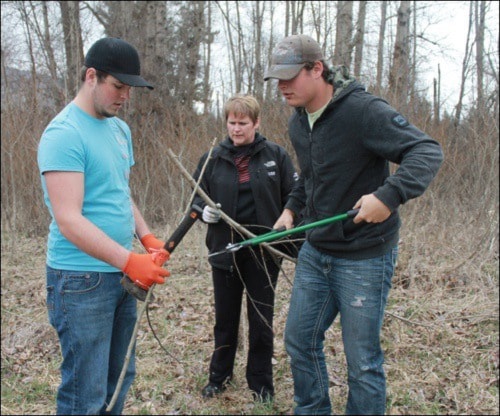Boothman’s Oxbow Provincial Park is undergoing a transformation from old unused fields to valuable wildlife habitat.
This park is located east of Grand Forks and was established in 2007. The restoration project is being led by the Boundary Invasive Species Society in partnership with BC Parks, Granby Wilderness Society, Christina Lake Stewardship Society and the Ministry of Forests, Lands and Natural Resource Operations.
EcoAction, an Environment Canada funding program, has approved funding of $27,439 to be spent over the next two years on enhancing habitat values within the park.
Work has already begun with volunteers installing short barrier fences to control amphibian (frogs, toads and salamander) movements in and out of the upper bench area. Within the next few weeks, the upper field will be plowed down, but everyone needs to make sure that the amphibians are out first.
There are several species at risk using the park including botched tiger salamanders and Great Basin spadefoots, so these measures will protect them while we enhance their habitat.
Jenny Coleshill of the Granby Wilderness Society is helping by co-ordinating the fence installation and she will have volunteers monitoring the fences for amphibians in the coming weeks to make sure they are all on the right side of the fence.
The materials for the fence were all donated, with Emcon Services donating sand, BC parks donating stakes and leftover lumber wrap from Interfor from last year’s amphibian fence project undertaken by the Boundary Habitat Stewards.
Before anything can be planted on the upper grassland bench though, the quackgrass and invasive plants need to be controlled, so the field will be fallow all summer and planting of native plants will not start until late September.
Finding native seed stock has been a challenge and the Boundary Central Secondary School Grade 12 Resource Management class, taught by Lisa Baia, will be growing some of the native plants for the project. Most of the native bunch grass for the project is being grown by a nursery, with some of the funding from EcoAction.
The class was out at the oxbow two weeks ago to learn about restoration and to help with planting some live cottonwood stakes along the oxbow. Near the oxbow groups are trying to establish a strip of shrubs and trees to improve habitat for bird and other species. Right now the introduced reed canary grass dominates and it provides little habitat value for wildlife.
The class was laying down temporary tarps to control the grass and planting live cottonwood whips through the tarp. In the coming months the class will work on growing the native plants for the project.
As the project progresses, classes from other schools will be invited to help with tasks including invasive plant removal and planting native bunchgrass, shrubs and trees.
If you use the park please be patient while groups work to enhance habitat values and them know if you want to help out as a volunteer or have any concerns about the project.
For more information on the project contact Barb Stewart at 250-446-2232 or email boundaryinvasives@gmail.com. You can also contact Jenny Coleshill at jenny.coleshill@granbywilderness.ca.
The Government of Canada’s EcoAction Community Funding Program supports projects that rehabilitate, protect or enhance the natural environment and builds the capacity of communities and individuals to ensure future protection.
– Submitted by Barb Stewart, Boundary Invasive Species Society
